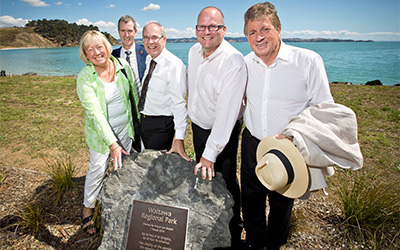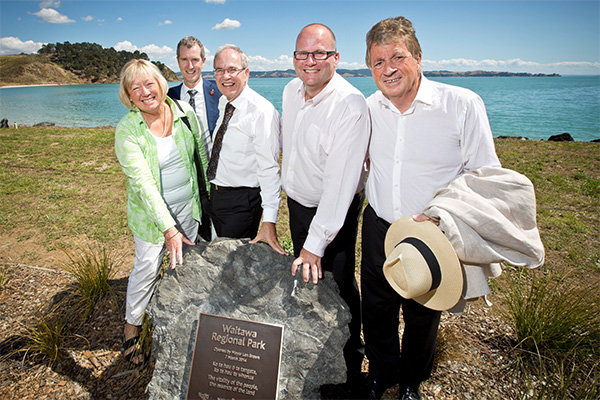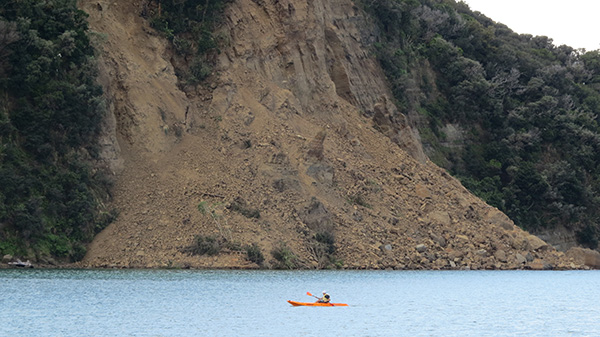50th celebrations avert requiem for regional parks


Yes Councillor: Fortunately for future generations of Aucklanders, governing body councillors Christine Fletcher, left, and Mike Lee, right, were not fooled by senior council executives and their bald assertion that their plan for splitting the Auckland Regional Parks network into three was merely an operational matter, not requiring the consent of elected representatives. Meanwhile, the large slip that took out the road to the bay in the Waitawa Regional Park being opened here has swallowed up budget that might have gone towards bringing other new parkland, such as Te Muri, into use. image Jay Farnworth/Auckland Council
It’s 35 years since Yes Minister first ran, yet public servants still shamelessly subvert the democratic process as effortlessly as breathing. In a particularly preposterous case of usurping the authority of elected representatives, Auckland Council senior management had decided to split the Auckland Regional Parks network into three, without seeking the consent of the parks, recreation and sport committee, much less the governing body of Auckland Council, and in the year in which the 50th anniversary of the regional parks network is to celebrated.
The staggering absurdity of the plan was that the regional parks network has more potential to endear Aucklanders to their new regional governance arrangement than any other service it provides. To use the proposed Mahurangi Coastal Trail as an example, for a fifth of the cost the council’s default development practice, the trail could be built and a $15 million park could be opened to the public as the culmination of the 2015–2016 celebratory year. Auckland Council plans to spend at total of $6 billion per year over the next 10 years, but has budgeted only 0.017% of that ($1 million annually) for the development of new, already acquired, parkland. Auckland Council is sitting on thousands of acres of such parkland, including the 407-hectare Schischka farm at Te Muri, that, by working with the community, the council could open up to Aucklanders in short order and for a pittance.
While restructuring might be the last refuge of a clueless elite, it could well be that the regional parks hierarchy could benefit from changes—flattening would seem to be suggested. But the recent proposal would have left the highest ranking (purely) regional park manager relegated to the sixth tier, two tiers lower than the existing manager of regional parks. Moreover, dividing the regional parks network into three would surely have reinforced the now widespread belief that a single Auckland Council was a mistake, and would have provided free ammunition for the faction attempting to carve a separate unitary authority out of northern Rodney. The regional parks network, rather than being threatened with dismemberment, should be used to demonstrate exactly why regional governance is great for Aucklanders.
Whether it’s the mental and physical health of Aucklanders, or the necessity of slashing greenhouse gas emissions, it is imperative that urban sprawl is addressed, and swiftly in respect to the latter issue. If northern Rodney was hived off as an autonomous district, it would instantly degenerate into a gas-guzzling, developers’ El Dorado, with Mangawhai being a lamentable local example of what can happen immediately beyond a regional border, where the appetite for coastal retreats is poorly managed. A healthy city needs a healthy hinterland, and the need for regional governance was established more than six decades ago with the creation of the Auckland Regional Planning Authority, in 1954.

Unbudgeted: This Wenderholm Regional Park landslide is an unwelcome reminder of costs that the regional parks network will increasingly face as a consequence of global warming. In this case, the surface of the slip needs to be urgently planted in pohutukawa before weeds get the upper hand. Short of barging away the tens of thousands of tonnes of rock and soil, this slip will be a weeping source of sediment until, in the fullness of time, it is all eaten away by the costly combination of sea-level rise, and larger extreme waves and storm surges. image Sarah Ransom
This is not the first time since amalgamation that the regional parks network has been threatened. The first assault was when local boards were enticed into a grab for control, in 2011. This was seen off, but only after a concerted fightback spearheaded by Friends of Regional Parks and supported by at least seventeen organisations, many of them dedicated to supporting individual regional parks. The latest threat has also seen off, thanks to the fierce advocacy of Christine Fletcher, chair of Auckland Council’s parks, recreation and sport committee, and Councillor Mike Lee, last chairman of the now subsumed regional council, and strongly supported by Friends of Regional Parks.
Friends of Regional Parks was formed precisely to counter this sort of threat. Founding chairman, Bill Burrill, was acutely aware that within the new Auckland Council both staff members and politicians would typically lack the understanding of the heritage and importance of the regional parks network that was deeply embedded in the regional council with which he had served as a councillor including, for three terms, as chairman of the regional parks committee. A passion for big parks runs in his family with his father, Max, having gifted the government 3600 hectares of Great Barrier Island for posterity. Similarly, the organisation’s founding deputy chair, Bronwen Turner, as a planner and daughter of Judge Arnold Turner CMG—one of the two fathers of Auckland Regional Parks—was seriously concerned that the network would be underappreciated by its new masters. That the regional parks network has had to be fought for three times in five years—the other occasion being when an attempt was made to deny recent regional park acquisitions protection in perpetuity—is ample proof that Friends of Regional Parks needs to be a force that can’t be lightly fobbed off by council executive officers. That, and the fact that there is no budget for new acquisitions in Auckland Council’s long-term plan. This latter situation, unless addressed, will lead to Aucklanders missing out on key additions to the regional parks network that might otherwise have dropped neatly into the council’s lap, as a prime headland did recently on Mahurangi Peninsula.
Without Christine Fletcher and Mike Lee swiftly swinging determinedly into action, Friends of Regional Parks could not, on its own, have convinced Auckland Council bosses to keep the regional parks network intact, and Mahurangi Action, instead of supporting the Auckland Regional Parks 50th anniversary celebrations, would be planning a requiem.
Mahurangi Action members could hold the key to a strategy whereby Friends of Regional Parks could boast a membership of thousands, commensurate with the four-to-five million visits the regional parks network receives every year. This is whereby those members of Mahurangi Action who are willing, would pay a levy of say $5 on top of their subscriptions to become affiliated members of Friends of Regional Parks. Any of the ‘Friends of’ associations could have led the charge, but Mahurangi Action has a particular incentive and duty, given that Friends of Regional Parks, by making the Mahurangi Coastal Trail its flagship project, has virtually guaranteed its realisation.
And now is the time to trial the concept, with subscriptions for Mahurangi Action’s 2015–2016 financial year now due.
